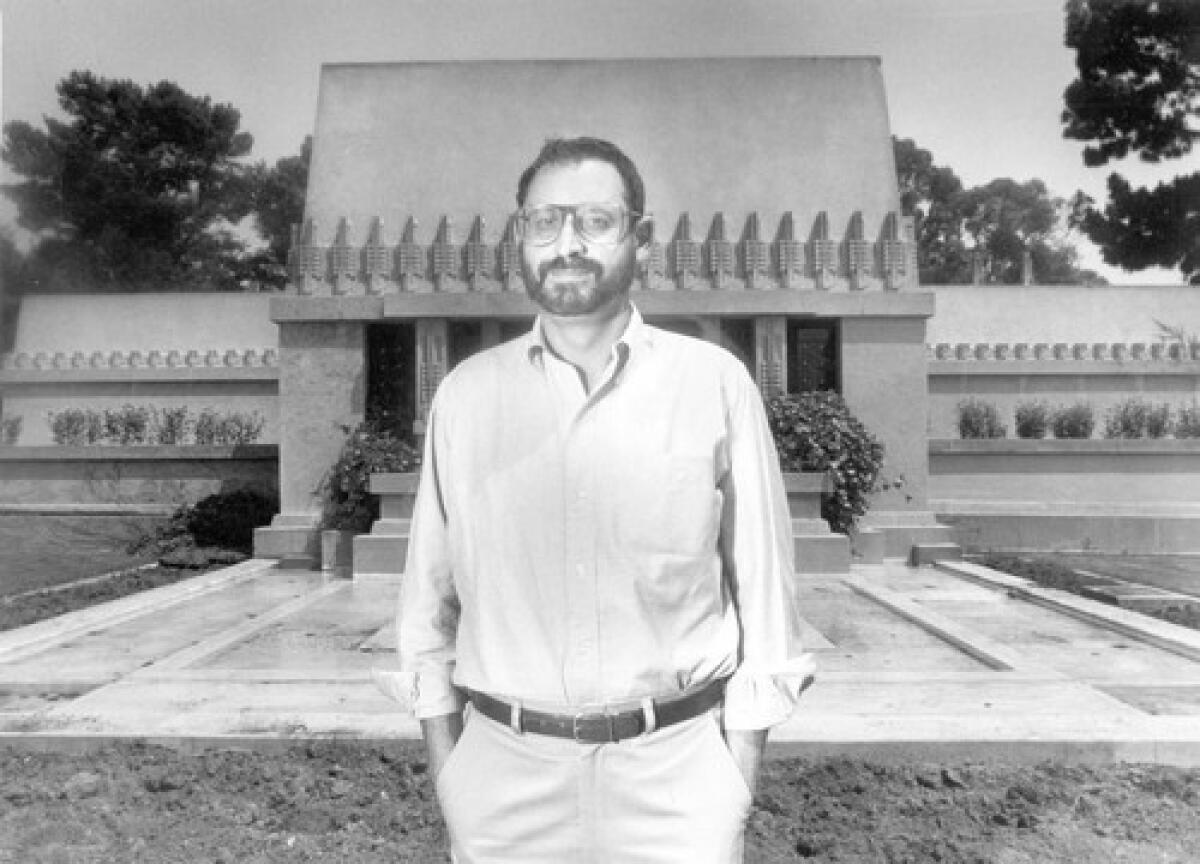Martin Eli Weil dies at 68; restoration architect and founding member of the L.A. Conservancy

- Share via
Martin Eli Weil, a leading restoration architect and a past president of the Los Angeles Conservancy who was involved in the restoration of landmark structures such as the El Capitan Theatre and the Frank Lloyd Wright-designed Storer House in the Hollywood Hills, has died. He was 68.
Weil, a longtime resident of the historic West Adams area of Los Angeles, died at his home in the Harvard Heights neighborhood. His body was found Tuesday by a neighbor, said Lauren Schlau, a friend, who said Weil died of a presumed heart attack.
“This is a big loss for the preservation community,” said Schlau, a past president of the West Adams Heritage Assn. “Martin was a beacon of light everywhere he went in terms of his knowledge, his contributions, his commitment, his vision.”
An expert in historic design, materials and colors, Weil specialized in restoration projects of landmark historic homes and other properties, including serving as a consultant on the restoration and preservation of the Henry and Arabella Huntington mausoleum at the Huntington Library, Art Collections and Botanical Gardens in San Marino.
In the early ‘80s, Weil and Eric Lloyd Wright, grandson of Frank Lloyd Wright, were the restoration architects on the 1923 Storer House.
“He was very knowledgeable about methods of restoration and very helpful in that way -- how to restore things without damaging them or doing improper methods,” Wright said. “He also was very good at research, getting information about the history of the building.”
Weil was a founding member of the Los Angeles Conservancy, formed in 1978 as part of the community-based effort to prevent the demolition of the Los Angeles Central Library and other threatened landmarks.
He served two stints as president of the conservancy in the ‘80s and was involved in the preservation of landmarks including Pasadena City Hall and the Watts Towers.
“In the world of historic preservation, he was considered to be a key resource throughout the region,” said Ruthann Lehrer, who served as the conservancy’s first executive director. “He had a passion for historic buildings, and he was a great teacher and a great inspiration to all who worked with him.”
In a 1980 interview with The Times, Weil said the conservancy “was started by a group of people who were distressed because old buildings were coming down all over Los Angeles.”
“It was a question of concern over preserving what was left of Los Angeles,” he said. “There was no voice for what was happening to these old buildings.”
As a restoration architect, Weil was known for what a Times writer in 1989 referred to as his “scrupulous attention to detail.”
That was evident after he began scraping away the layers of paint on the living room walls of Frank Lloyd Wright’s Hollyhock House and was unable to find any trace of the original color scheme.
“I felt terribly frustrated,” Weil told The Times. “I was faced with the tricky task of second-guessing Frank Lloyd Wright based on his color schemes for other Mayan houses he designed in Los Angeles. Then the gods gave me a break.”
He accidentally discovered that paint flakes from the original color scheme had fallen into the lighting soffits in the living room.
“We analyzed these flakes chemically and microscopically,” he said. “The analysis revealed Wright used a very particular kind of paint mixed in with grains of sand to achieve a ‘desert’ finish. And often he’d lay two or three colors one over another, to give a glow to the paint work.”
Within the last year, Weil was the color consultant for the exterior restoration of the Villa Riviera, a landmark 16-floor Renaissance Revival chateau on Ocean Boulevard in Long Beach that was built in 1928.
Weil, who also served as a restoration architectural consultant for the cities of San Gabriel and La Verne, worked out of his home: a 1905 Greene & Greene-designed Craftsman bungalow that he moved into in 1985 and restored.
Weil, who often shared his advice and expertise with neighbors who were restoring their historic homes, was an early member of the 25-year-old West Adams Heritage Assn.
In recognition of his preservation efforts, the organization created the Martin Eli Weil Preservation Award and named him the first recipient in 2006.
Born in Glasgow, Mont., on July 2, 1940, Weil earned a bachelor’s degree from the University of Iowa before receiving a master’s in architecture from the University of Pennsylvania. He also had a master’s in early American culture and decorative arts from the University of Delaware.
In the 1970s, he was chief restoration architect in the Canadian Department of Indian and Northern Affairs in Ottawa.
He is survived by his brothers, Jesse and Peter.
Weil was the prime mover to establish Friends of Sim Shalom, which provides financial support to the Sim Shalom congregation in Budapest, Hungary, where his sister-in-law is the rabbi. His family suggests that donations in Weil’s memory be made online at www.friendsofsimshalom.org, or to other charitable organizations.
A memorial service is pending.
More to Read
Start your day right
Sign up for Essential California for the L.A. Times biggest news, features and recommendations in your inbox six days a week.
You may occasionally receive promotional content from the Los Angeles Times.






